Islands of Ireland: Taking the blueway to visit Horse Island

Horse Island, Bantry Bay — with kayaker on the blueway. Picture: Dan MacCarthy
For an expanse of water that measures only about 10km sq, the inner part of Bantry Bay, County Cork, between Whiddy Island and the mainland has had an astonishing number of shipwrecks over the years. Wrecks are recorded on the archaeology.ie website with 55 red dots representing sunken vessels on this part of Bantry Bay — looking like an outbreak of measles.
Horse Island is a small rocky island which can be one of the waystops on the Bantry Bay blueway. The gorgeous kayak route has as its main destination the historically rich Whiddy Island. However, it encompasses four other islands as well: Rabbit, Hog, Chapel, and Horse. All, bar Whiddy, are uninhabited.










